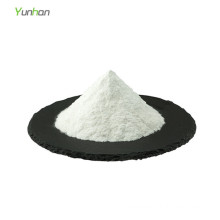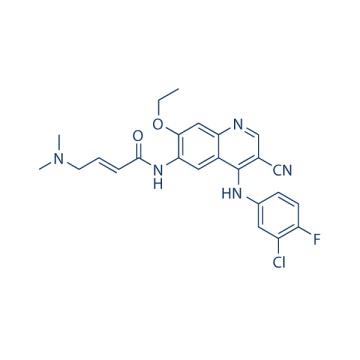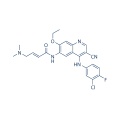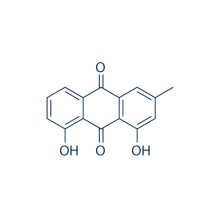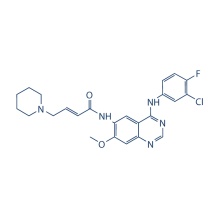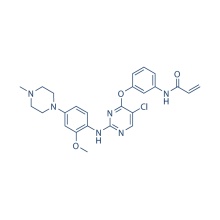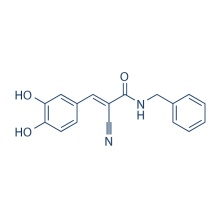Pelitinib (EKB-569) 257933-82-7
Product Description
.cp_wz table {border-top: 1px solid #ccc;border-left:1px solid #ccc; } .cp_wz table td{border-right: 1px solid #ccc; border-bottom: 1px solid #ccc; padding: 5px 0px 0px 5px;} .cp_wz table th {border-right: 1px solid #ccc;border-bottom: 1px solid #ccc; padding: 5px 0px 0px 5px;}
Molecular Weight:
467.92 Pelitinib (EKB-569) is a potent irreversible EGFR Inhibitor with IC50 of 38.5 nM. Phase2.
Biological Activity
Pelitinib displays much higher inhibitory activity against EGFR,
compared with the closely related c-erbB-2, as well as other kinases
such as Src, Cdk4, c-Met, Raf, and MEK/ERK, with IC50 ranging from 282
nM for Src to >20 μM for Cdk4. Consistently, Pelitinib treatment
significantly inhibits the autophosphorylation of EGFR but not c-Met in
A431 cells. Pelitinib potently inhibits the proliferation
of normal human keratinocytes (NHEK), as well as A431 and MDA-468 tumor
cells with IC50 of 61 nM, 125 nM, and 260 nM, respectively, while
displaying little activity against MCF-7 cells with IC50 of 3.6 μM.
Pelitinib inhibits EGF-induced phosphorylation of EGFR in A431 and NHEK
cells with IC50 of 20-80 nM, as well as the phosphorylation of STAT3
with IC50 of 30-70 nM.
Pelitinib at 75-500 nM also specifically inhibits
the activation of AKT and ERK1/2, without affecting NF-κB pathway. In
NHEK cells, Pelitinib also potently inhibits TGF-α mediated EGFR
activation with IC50 of 56 nM, as well as activation of STAT3 and ERK1/2
with IC50 of 60 nM and 62 nM, respectively.
A single oral dose of 10 mg/kg Pelitinib potently inhibits the EGFR
phosphorylation in A431 xenografts with over-expressed EGFR, by 90%
within 1 hour, and by >50% after 24 hours. Administration of
Pelitinib at 20 mg/kg/day inhibits tumorigenesis in APCMin/+ mice by 87%, equivalent to the effect of used with 2 times doses of
EKI-785 (40 mg/kg/day), consistent with greater in vivo potency.
Pelitinib selectively inhibits EGFR signaling in airway epithelial
cells in vivo. In the mouse model of airway epithelial remodeling that
is inducible by viral infection and features a delayed but permanent
switch to goblet cell metaplasia, Pelitinib treatment at 20 mg/kg/day
corrects all 3 aspects of epithelial remodeling, by completely blocking
the increase of ciliated cells and decrease of Clara cells, and
significantly inhibiting the metaplasia of goblet cells.
Protocol(Only for Reference)
Kinase Assay: [1]
Cell Assay: [2]
Animal Study: [1]
Conversion of different model animals based on BSA (Value based on data from FDA Draft Guidelines)
For example, to modify the dose of resveratrol used for a mouse (22.4 mg/kg) to a dose based on the BSA for a rat, multiply 22.4 mg/kg by the Km factor for a mouse and then divide by the Km factor for a rat. This calculation results in a rat equivalent dose for resveratrol of 11.2 mg/kg.
Chemical Information
Molarity Calculator
Dilution Calculator
Molecular Weight Calculator
Contact us if you need more details on 257933-82-7. We are ready to answer your questions on packaging, logistics, certification or any Other aspects about Pelitinib 257933-82-7、EKB-569 257933-82-7. If these products fail to match your need, please contact us and we would like to provide relevant information.
Molecular Weight:
467.92 Pelitinib (EKB-569) is a potent irreversible EGFR Inhibitor with IC50 of 38.5 nM. Phase2.
Biological Activity
Pelitinib displays much higher inhibitory activity against EGFR,
compared with the closely related c-erbB-2, as well as other kinases
such as Src, Cdk4, c-Met, Raf, and MEK/ERK, with IC50 ranging from 282
nM for Src to >20 μM for Cdk4. Consistently, Pelitinib treatment
significantly inhibits the autophosphorylation of EGFR but not c-Met in
A431 cells. Pelitinib potently inhibits the proliferation
of normal human keratinocytes (NHEK), as well as A431 and MDA-468 tumor
cells with IC50 of 61 nM, 125 nM, and 260 nM, respectively, while
displaying little activity against MCF-7 cells with IC50 of 3.6 μM.
Pelitinib inhibits EGF-induced phosphorylation of EGFR in A431 and NHEK
cells with IC50 of 20-80 nM, as well as the phosphorylation of STAT3
with IC50 of 30-70 nM.
Pelitinib at 75-500 nM also specifically inhibits
the activation of AKT and ERK1/2, without affecting NF-κB pathway. In
NHEK cells, Pelitinib also potently inhibits TGF-α mediated EGFR
activation with IC50 of 56 nM, as well as activation of STAT3 and ERK1/2
with IC50 of 60 nM and 62 nM, respectively.
A single oral dose of 10 mg/kg Pelitinib potently inhibits the EGFR
phosphorylation in A431 xenografts with over-expressed EGFR, by 90%
within 1 hour, and by >50% after 24 hours. Administration of
Pelitinib at 20 mg/kg/day inhibits tumorigenesis in APCMin/+ mice by 87%, equivalent to the effect of used with 2 times doses of
EKI-785 (40 mg/kg/day), consistent with greater in vivo potency.
Pelitinib selectively inhibits EGFR signaling in airway epithelial
cells in vivo. In the mouse model of airway epithelial remodeling that
is inducible by viral infection and features a delayed but permanent
switch to goblet cell metaplasia, Pelitinib treatment at 20 mg/kg/day
corrects all 3 aspects of epithelial remodeling, by completely blocking
the increase of ciliated cells and decrease of Clara cells, and
significantly inhibiting the metaplasia of goblet cells.
Protocol(Only for Reference)
Kinase Assay: [1]
| Autophosphorylation of EGFR in cells | For experiments using cells in culture, A431 cells are treated with various concentrations of Pelitinib for 2.75 hours before co-incubation with 100 ng/mL EGF for 0.25 hour. Cells are washed twice with cold phosphate-buffered saline (PBS) before adding to lysis buffer (10 mM Tris, pH 7.5, 5 mM ethylenediamine tetra-acetic acid (EDTA), 150 mM NaCl, 1% Triton X-100, 1% Sodium deoxycolate, 0.1 % SDS, 1 mM PMSF, 10 mg/mL pepstatin A, 10 mg/mL leupeptin, 20 KIU/mL aprotinin, 2 mM sodium orthovanadate, and 100 mM sodium fluoride) for 20 minutes on ice, before immunoprecipitation and SDS-PAGE-immunoblotting. For immunoprecipitation, cultured cells are placed in cold lysis buffer and immediately homogenized on ice with a polytron with several pulses. The homogenate is first centrifuged at 2500 rpm (20 minutes, 4 °C) and then again at 14,000 rpm in a microcentrifuge (10 minutes, 4 °C). Supernatants (1000 μg protein) are incubated for 2 hours at 4 °C with 15 mL of EGFR polyclonal antibody. After 2 hours, 50 μL of protein G plus/protein A agarose beads is added and incubated with constant rotation for 2 hours at 4 °C. After washing with lysis buffer, beads are boiled for 2 minutes in Laemmli sample buffer. Proteins are then resolved by SDS-PAGE, transferred to immobilon membrane and probed overnight with an anti-phosphotyrosine antibody conjugated with horseradish peroxidase (HRP). Membranes are developed using the ECL reagent. Total EGFR protein is determined by stripping membranes and re-probing with receptor-specific antibodies. Quantitation of bands is done by densitometry, using ImageQuant software with a Molecular Dynamics laser transmittance scanner. |
|---|
Cell Assay: [2]
| Cell lines | NHEK, A431, MCF-7, and MDA-468 |
|---|---|
| Concentrations | Dissolved in DMSO, final concentrations ~10 μM |
| Incubation Time | 5 days |
| Method | Cells are seeded in 96-well dishes, and after 2 hours, Pelitinib is added and incubated for 5 days. After incubation, the medium is removed from each well and fresh medium (150 μL) + 1 mg/mL MTT solution (50 μL) is added. After incubation for 2 hours at 37 °C, the medium is replaced with 150 μL DMSO, and absorbance at 540 nm in each well is determined. The IC50 is calculated by linear regression of the data. |
Animal Study: [1]
| Animal Models | Athymic nu/nu female mice bearing subcutaneous A431 tumors, or APCMin/+ male mice, a murine model of human familial adenomatous polyposis (FAP) | ||
|---|---|---|---|
| Formulation | Dissolved in pH 2.0 water | ||
| Dosages | 10, or 20 mg/kg/day | ||
| Administration | Oral gavage | ||
| Solubility | 30% PEG400/0.5% Tween80/5% propylene glycol, 30 mg/mL | ||
| * Please note that Selleck tests the solubility of all compounds in-house, and the actual solubility may differ slightly from published values. This is normal and is due to slight batch-to-batch variations. | |||
Conversion of different model animals based on BSA (Value based on data from FDA Draft Guidelines)
| Species | Baboon | Dog | Monkey | Rabbit | Guinea pig | Rat | Hamster | Mouse |
| Weight (kg) | 12 | 10 | 3 | 1.8 | 0.4 | 0.15 | 0.08 | 0.02 |
| Body Surface Area (m2) | 0.6 | 0.5 | 0.24 | 0.15 | 0.05 | 0.025 | 0.02 | 0.007 |
| Km factor | 20 | 20 | 12 | 12 | 8 | 6 | 5 | 3 |
| Animal A (mg/kg) = Animal B (mg/kg) multiplied by | Animal B Km |
| Animal A Km |
For example, to modify the dose of resveratrol used for a mouse (22.4 mg/kg) to a dose based on the BSA for a rat, multiply 22.4 mg/kg by the Km factor for a mouse and then divide by the Km factor for a rat. This calculation results in a rat equivalent dose for resveratrol of 11.2 mg/kg.
| Rat dose (mg/kg) = mouse dose (22.4 mg/kg) × | mouse Km(3) | = 11.2 mg/kg |
| rat Km(6) |
Chemical Information
| Molecular Weight (MW) | 467.92 |
|---|---|
| Formula | C24H23ClFN5O2 |
| CAS No. | 257933-82-7 |
| Storage | 3 years -20℃Powder |
|---|---|
| 6 months-80℃in solvent (DMSO, water, etc.) | |
| Synonyms | |
| Solubility (25°C) * | In vitro | DMSO | 13 mg/mL (27.78 mM) |
|---|---|---|---|
| Water | <1 mg/mL ( | ||
| Ethanol | <1 mg/mL ( | ||
| In vivo | 30% PEG400/0.5% Tween80/5% propylene glycol | 30 mg/mL | |
| * <1 mg/ml means slightly soluble or insoluble. * Please note that Selleck tests the solubility of all compounds in-house, and the actual solubility may differ slightly from published values. This is normal and is due to slight batch-to-batch variations. | |||
| Chemical Name | (E)-N-(4-(3-chloro-4-fluorophenylamino)-3-cyano-7-ethoxyquinolin-6-yl)-4-(dimethylamino)but-2-enamide |
|---|
Molarity Calculator
Dilution Calculator
Molecular Weight Calculator
Contact us if you need more details on 257933-82-7. We are ready to answer your questions on packaging, logistics, certification or any Other aspects about Pelitinib 257933-82-7、EKB-569 257933-82-7. If these products fail to match your need, please contact us and we would like to provide relevant information.
Product Categories : Protein Tyrosine Kinase > EGFR Inhibitor
Other Products
Hot Products
Astragaloside AChlortetracycline HCl 64-72-2Paclitaxel 33069-62-4Dexamethasone Acetate 1177-87-3Dinaciclib (SCH727965) 779353-01-4CHIR-124 405168-58-3Ro3280 1062243-51-9TAME 901-47-3CCG-1423 285986-88-110058-F4 403811-55-2Dabigatran (BIBR 953) 211914-51-1H 89 2HCl 130964-39-5T0901317 293754-55-9Aprepitant 170729-80-3Turofexorate Isopropyl (XL335) 629664-81-9BMS-378806 357263-13-9








